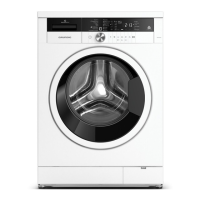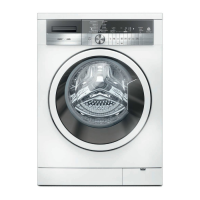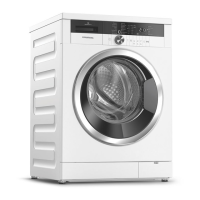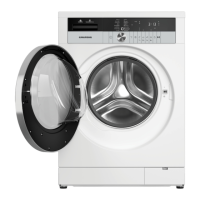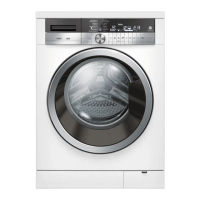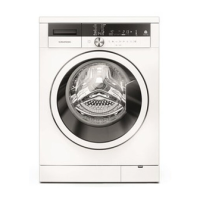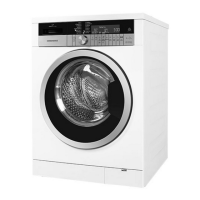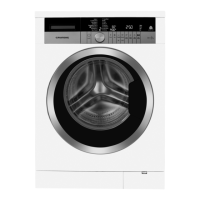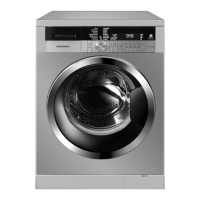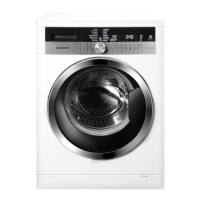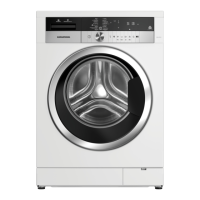Do you have a question about the Grundig GWN 37230 S and is the answer not in the manual?
General safety guidelines for product usage by children and adults.
Safety precautions related to electrical connections and potential hazards.
Precautions regarding water leakage, door operation, and correct detergent usage.
Specifies the product is for domestic use only and its intended functions.
Warnings about keeping children away from packaging and the machine.
Information on product compliance with EU WEEE Directive for waste electrical equipment.
Product compliance with EU RoHS Directive regarding prohibited materials.
Details about the product's recyclable packaging materials.
Illustrates and labels the main external components of the washing machine.
Recommendations for placing the machine on a stable, level surface away from heat and moisture.
Instructions on how to remove protective packaging materials before use.
Detailed steps to remove safety bolts essential for safe transport before operating the machine.
Instructions on connecting the water inlet hose, including pressure requirements and warnings.
Guidance on how to properly connect the drain hose for water discharge, including height and length considerations.
Steps to ensure the machine is level and stable by adjusting its feet to minimize vibration and noise.
Essential information on safely connecting the machine to a grounded electrical outlet.
Procedures for preparing the machine for transport, including draining and securing it.
Advice on categorizing laundry by fabric type, color, and soiling level before washing.
Specific instructions on how to prepare different types of laundry items for washing.
Tips for operating the washing machine efficiently to save energy and water.
Instructions for the very first operation of the washing machine, often a drum cleaning cycle.
Guidance on determining the appropriate amount of laundry for optimal washing performance.
Steps on how to properly load laundry into the machine's drum.
Detailed guide on how to use detergents and softeners, including compartment usage and dosage.
Information on selecting and using various cleaning agents like detergents, softeners, and bleaches.
Advice on selecting the correct type of detergent based on fabric color, type, and special needs.
Recommendations for optimizing washing cycles for different types of clothes and soiling levels.
Identifies and explains the function of each button and display element on the control panel.
Steps to take before starting a wash cycle, including hose connections and loading.
Guide on how to choose the appropriate wash program based on laundry type and soiling.
Detailed explanation of the different wash programs available, their uses, and specific instructions.
Description of the HygieneCare program for anti-allergic and hygienic washing at high temperatures.
Explanation of the Delicate program for gentle washing of fragile clothing items.
Details on the Hand Wash program for woollen or delicate items requiring gentle care.
Information on the Mini 14' program for quick washing of lightly soiled cotton laundry.
Program for washing lightly soiled cotton clothes in a short time.
Program designed for dark colored laundry to prevent fading, using gentle actions and low temperatures.
Program for washing cotton, synthetic, and blended shirts together.
Program for washing lightly soiled cotton laundry quickly.
Maintenance program for cleaning the washing machine's drum and ensuring hygiene.
Lists and explains specific programs for particular applications like rinsing or draining.
How to adjust the wash temperature for selected programs, with guidance on gradual decrease.
Instructions on how to choose and adjust the spin speed for different wash programs.
Function to keep laundry in rinse water to prevent wrinkles, with options to drain or spin.
Explanation of the Prewash function for heavily soiled laundry and its impact on resource saving.
Function to add an extra rinse cycle, beneficial for sensitive skin and removing detergent remnants.
Program for quiet and energy-saving washing, cancelling spin steps and ending with Rinse Hold.
Steps to initiate a wash cycle after program and function selection, including indicator lights.
What happens when a program finishes, including indicator lights and auto-off mode.
How to adjust the volume level for program notifications and alerts.
Explanation of the machine's standby mode, where it powers off after inactivity.
Essential checks and actions before starting a wash cycle.
Guidance on choosing the correct program based on laundry characteristics.
How to select and combine additional functions for a tailored wash.
Steps to commence the selected washing program.
Indicates what happens upon program completion and the machine's standby behavior.
Instructions on how to abort an active wash program.
How to activate and deactivate the child lock feature to prevent unintended changes.
Explains the function of the door lock system and the 'Door Locked' indicator.
Guidance on pausing the machine and modifying settings or adding laundry during a cycle.
Instructions for activating and deactivating the child lock feature.
How to adjust program parameters like auxiliary functions, spin speed, and temperature mid-cycle.
Solutions for issues where the washing program fails to initiate after closing the door.
Troubleshooting steps for when the washing machine does not respond to program selection or startup.
Explains the presence of residual water due to quality control and reassures it's not a fault.
Addresses potential causes of water leaks from the machine's base, such as hose or filter issues.
Steps to diagnose why the machine is not filling with water, checking taps, hoses, and filters.
Troubleshooting for problems with water not draining, focusing on the drain hose and pump filter.
Solutions for excessive vibration or noise, including checking balance, transportation bolts, and load.
Explains temporary stops due to low voltage and automatic resumption.
Addresses issues where the machine discharges water immediately upon intake, often due to hose height.
Clarifies that the water level not being visible externally is normal and not a fault.
Reasons why the door might not open, including water level, child lock, or pressure, and how to resolve them.
Explains factors that can extend program duration, like low water pressure or voltage, and excessive foam.
Reasons why the timer might pause during water intake, heating, or spinning phases.
Identifies causes for the machine not proceeding to the spin cycle, such as imbalance or incomplete draining.
Troubleshooting steps for laundry turning grey, likely due to detergent issues or low-temperature washing.
Solutions for persistent stains or lack of whitening, involving detergent, program selection, and load.
Addresses oily stains by recommending regular drum cleaning.
How to prevent unpleasant odors by ensuring proper ventilation after washing and regular cleaning.
Reasons for color fading, such as overloading or incorrect temperature selection.
Solutions for inadequate rinsing, related to detergent type, storage, or compartment usage.
Causes for laundry stiffness, including insufficient detergent or mixing softener with detergent.
Addresses issues where the softener's scent is not noticeable, potentially due to compartment or mixing issues.
Tips for preventing detergent residue, including dry storage and checking compartment holes.
Reasons for detergent residue on clothes, like overloading or wrong program selection.
How to manage excessive foam caused by incorrect detergent usage or storage.
Solutions for foam overflowing the detergent drawer, primarily related to detergent quantity.
Explains why laundry may remain wet, often due to excessive foam or imbalance.

